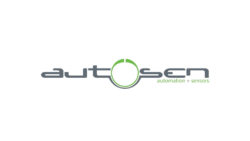The retroactive integration of IoT into an existing production facility often poses significant challenges for plant operators. Retrofitting almost always involves making modifications to the software of the existing plant. autosen demonstrates that it can be done differently with a pragmatic and scalable IoT concept for a leading brake pad manufacturer.
The challenge: Easy integration of IoT into an existing production plant
FRIMA FRIction MAterial Reibbelag GmbH – FRIMA for short – is a typical hidden champion: The medium-sized company based in Meinerzhagen is considered a pioneer for innovative brake pads. For more than 20 years, the manufacturer in Sauerland has been producing brake and clutch linings for industrial applications of all kinds. FRIMA products are used wherever linings and pads are needed: in drum or disc brakes, in trucks, trailers and machines all over the world, and even in roller coasters.
From the compounding of the individual, high-quality raw materials, to the design and shaping, to the ready-packed friction lining, FRIMA offers everything from a single source. The versatility of the machine park makes it possible to offer customers a wide range of parts.
In order to better monitor the utilization and condition of the hot presses and ultimately further increase productivity, FRIMA set out some time ago to find a suitable IoT retrofit solution. Not an easy task – as increasing productivity through IoT is considered complex and typically involves making modifications to the software of the existing facility. There are approximately 350 different communication drivers for countless different controllers. Hardly any end customer is in a position to retrofit such a solution. This means that a retrofit is not necessary in most cases.
For production managers, it is important to know the exact number of finished parts produced in the presses. After all, it is an important indicator of machine utilization and efficiency. Based on this information, forecasts can be made for order and production planning; deviations between target and actual can be detected and counteracted in good time. In practice, however, it is difficult to capture this information in real time. Not every pressing operation is completed. In addition, the number varies due to the change between shapes with four or six pads per run. The number of pressing operations therefore correlates only to a limited extent with the quantity of end products.
The obvious solution of installing an inductive sensor in each machine was ruled out at FRIMA due to the manual effort involved in filling and removing the parts during the production process. A new approach was therefore sought.
FRIMA finally found the optimal solution in a minimally invasive concept from autosen: the io-key.
The solution: Minimally invasive retrofit concept
The sensor and automation specialist from Essen thus offers a complete solution consisting of a wireless gateway, IIoT cloud and integrated connectivity with a data flat rate that can be used throughout Europe, in the USA and many other countries. As a plug-and-play solution, the io-key automatically recognizes over 20,000 industrial sensors from more than 350 manufacturers when they are connected. The data collected is transmitted via mobile communications regardless of location, without the need for configurations in the existing IT infrastructure. Data can be transferred to the cloud platform of choice, including AWS, Microsoft Azure, or other cloud environments.
The io-key uses IO-Link and a wireless connection to deliver sensor data directly to a cloud container called apollo. From there, the data is forwarded to the cloud interface via MQTT. From measurement to transfer to the customer cloud, the io-key and apollo take a maximum of a few seconds. When commissioning a sensor on the io-key for the first time, it takes about one minute until the first data point is available in the cloud. The io-key and apollo allow the user to select the cloud environment and sensor technology as desired, without any additional effort. The correct sensor values are automatically translated into the required format. The computing power for these services comes from the cloud. This means that the service is scalable and can use both AWS and other cloud providers. By adopting sensor identification as an open system, the user eliminates the need for all asset management.
In the unusual concept developed individually for FRIMA, a new tamper-proof counter was programmed into the PLC of the machines. This records only the pressing operations actually carried out, links these with information on the molds used and calculates the number of pieces from this.
Currently, seven machines are equipped with a counter. Each PLC is connected via cable to a third-party IO-Link distributor. A maximum of eight data sources can be connected to the autosen io-key in this way. Data is transferred to the cloud every ten seconds and displayed simultaneously in the same dashboard. Normally, the dashboard generates the display automatically, for example for temperature or level sensors. However, the “number of pieces” value required some individual adjustments, which FRIMA quickly implemented in close cooperation with autosen’s experts.
The result: Scalable retrofit solution without a single sensor
At FRIMA, the rollout is now planned across the entire press fleet. In the final expansion stage, all eleven machines will be equipped with it. In addition, further projects are already being considered in which autosen’s io-key can make even better use of its strengths, such as automatic sensor recognition via IO-Link. For example, by monitoring the presses via vibration sensors, operating states are recorded in order to detect malfunctions and signs of wear at an early stage.
With the scalable retrofit solution used, FRIMA can monitor the function of the presses in real time without a single sensor and optimize production planning. OT/IT integration is completely bypassed. Thus, io-key users can not only digitalize their production facilities much faster: It is also possible in places where no corresponding specialist personnel are available. The costs per plant are fixed from the start and are linearly transferable to further applications.






